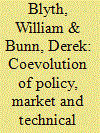| Srl | Item |
| 1 |
ID:
107630


|
|
|
|
|
| Publication |
2011.
|
| Summary/Abstract |
Within the EU, there have been calls for governments to provide greater certainty over carbon prices, even though it is evident that their price risk is not entirely due to policy uncertainty. We develop a stochastic simulation model of price formation in the EU ETS to analyse the coevolution of policy, market and technology risks under different initiatives. The current situation of a weak (20%) overall abatement target motivates various technology-support interventions, elevating policy uncertainty as the major source of carbon price risk. In contrast, taking a firm decision to move to a more stringent 30% cap would leave the EU-ETS price formation driven much more by market forces than by policy risks. This leads to considerations of how much risk mitigation by governments would be appropriate, and how much should be taken as business risk by the market participants.
|
|
|
|
|
|
|
|
|
|
|
|
|
|
|
|
| 2 |
ID:
112901


|
|
|
|
|
| Publication |
2012.
|
| Summary/Abstract |
In recognition of their competitive vulnerability, a set of special rules have been devised for managing sectors such as iron and steel within the EU ETS. Under these rules, the EU steel sector has received free allocations in excess of their compliance needs to now, and will continue to receive some free allowances up to 2020. However, perceptions of the sector's competitive vulnerability have been largely based on inherently hypothetical analyses which rely heavily on counterfactual scenarios and abatement cost estimates often provided by firms themselves. This paper explores how the three largest steel firms in the EU (AcerlorMittal, Corus, and ThyssenKrupp) have sought to strategically exaggerate their vulnerability to carbon pricing to the effect of an inefficient policy outcome. We conduct a qualitative assessment of two of the key narratives underpinning the competitive vulnerability argument of EU steel companies - lack of abatement opportunities and inability to pass through cost increases - based on interviews, case studies, and publicly available data. We find that these arguments provide only partial and weak justifications for competitive loss and preferential treatment under the EU ETS. The strategy however remains successful due to information asymmetry and the peculiar political economy of EU climate regulation.
|
|
|
|
|
|
|
|
|
|
|
|
|
|
|
|